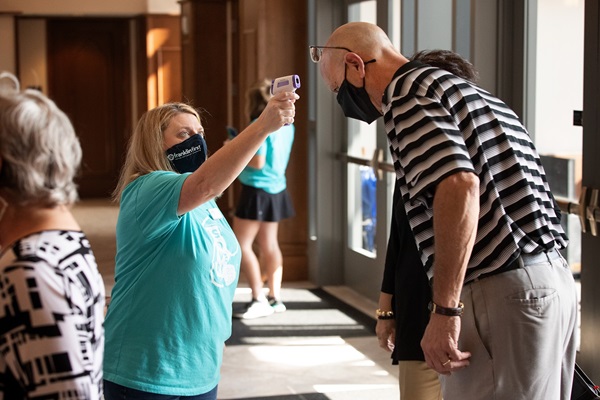After weeks of worshiping online, some United Methodist congregations are beginning to resume in-person services.
We are excited to go to church again, but it would be unrealistic to expect things to be as they were before the global pandemic.
“Worship will be different and feel strange,” one United Methodist church shares with their 'Guidelines for Reopening.' That’s good for each of us to keep in mind as we prepare to go back to church.
Please note: Those considered at high risk of contracting coronavirus are recommended to refrain from in-person worship gatherings at this time.
Not a comprehensive list
Because decisions and processes for resuming in-person worship are made by each United Methodist congregation in consultation with their district and annual conference, every church will approach things differently.
Maybe none of us will encounter all of these changes. Some may see something not mentioned here. Still, it is wise to consider what may be different.
Outdoor worship
Weather permitting, some congregations will worship outdoors, inviting us to stay in our vehicles and listen to the service on our car radio—similar to the old drive-in movie theaters. We can experiment with honking our horns instead of shouting ‘Amen!’ or applauding.
Others may ask us to bring a camping chair or blanket to church for worship on the lawn at a safe social distance. It can be an adventure!
Entering the building
If our congregation chooses to worship indoors, we may not be able to enter as we did previously. Certain doors may be designated as entrances and others as exits. Church leadership may also limit how long before the service we can enter the building.
Policies like these are especially helpful for congregations with multiple services. They allow us to maintain proper social distancing between those leaving the earlier service and those entering for a later service.
Health screenings may be performed at building entrances. Using a no-contact thermometer, a greeter may take our temperature on the way in, as a means of keeping us well during and after worship.
Masks will likely be required when entering the building and strongly encouraged for worship on the lawn. We may also notice hand sanitizer stations at entrances to the building, sanctuary or worship area.
Worship
To help maintain safe social distancing, seating will likely be modified. Pews may be roped off. Chairs might be rearranged. In some churches, an usher may escort our family to specific seats. We may not be able to sit in our regular spot—unthinkable!
Following plans like these help the congregation use the worship space most effectively until social distancing and occupancy restrictions are lifted.
It will be good to see our fellow worshipers in person again, but we’ll need to refrain from greeting them with hugs or handshakes for now. A nod of the head or a simple gesture like praying hands works almost as well, both before the service and during the passing of the peace.
We may not receive a printed bulletin and the hymnals, Bibles, attendance pads and the other high-touch items we’re used to seeing near our seats, may be removed.
Speaking of high-touch items, we probably won’t pass a collection plate for the offering. Instead, we’ll be invited to drop our offerings in a designated location on our way into or out of worship.
We can also continue to give online or via automatic withdrawal. Your congregation needs your continued financial support. Do you have concerns about digital offerings? Read ‘Understanding the safety of online giving... without getting too geeky’ for more helpful information.
Also, and this is a hard one for us United Methodists, congregational singing will likely be discouraged. So may responsive readings, congregational prayers and other worship elements that encourage us to join our voices. Maybe we’ll get to hum along to a hymn or praise song as we read the lyrics, which sometimes offers a new appreciation for words we’ve sung many times before.
Communion is another important part of our worship that congregations may suspend during this time. Others will choose to modify the practice. A common chalice, for example, will likely not be used. When the sacrament is offered, it’s okay not to participate if we’re uncomfortable.
Other possible changes
A less-sacred favorite of many United Methodists, the fellowship time before and after worship, will also likely be on hold. Not only is it difficult to serve food and beverages safely, our church doesn’t want to encourage us to gather too closely together during this time. Maybe we can each bring our own coffee and chat in the parking lot while maintaining a safe social distance.
Unfortunately, Sunday school classes, the nursery, childcare and other Sunday morning children and youth ministries may not be available. The rooms used for these activities are often not big enough to be able to maintain social distancing. It can also be difficult to convince a toddler she shouldn’t hug her friends.
Not ready? Worship online
If any of us don’t feel ready to return quite yet, that’s okay. We can continue to support our church by worshiping online until we’re more comfortable.
As we return, whether now or later, let us do it well. Stay healthy, and in the words of John Wesley, let's continue “to watch over one another in love,” whether together or from a safe social distance.
*Joe Iovino is Director, Member Content for United Methodist Communications. Contact him by email .
This story was originally published June 4, 2020.





